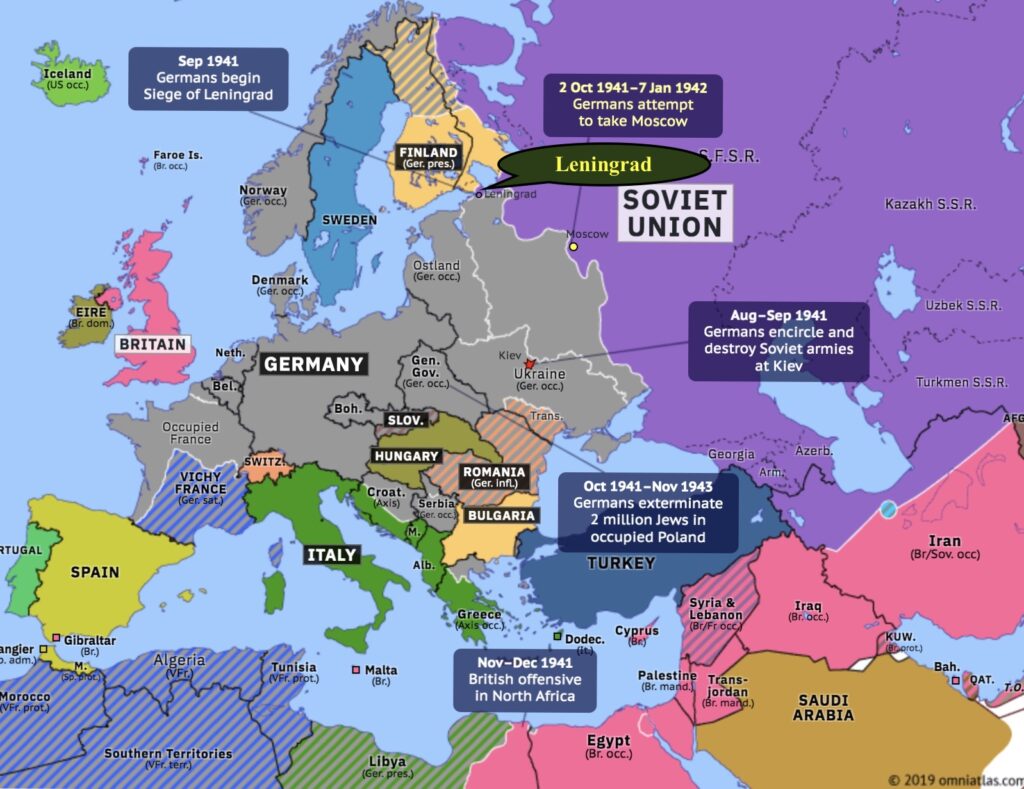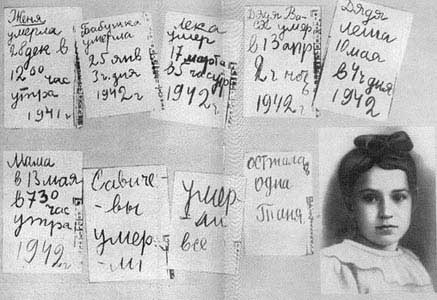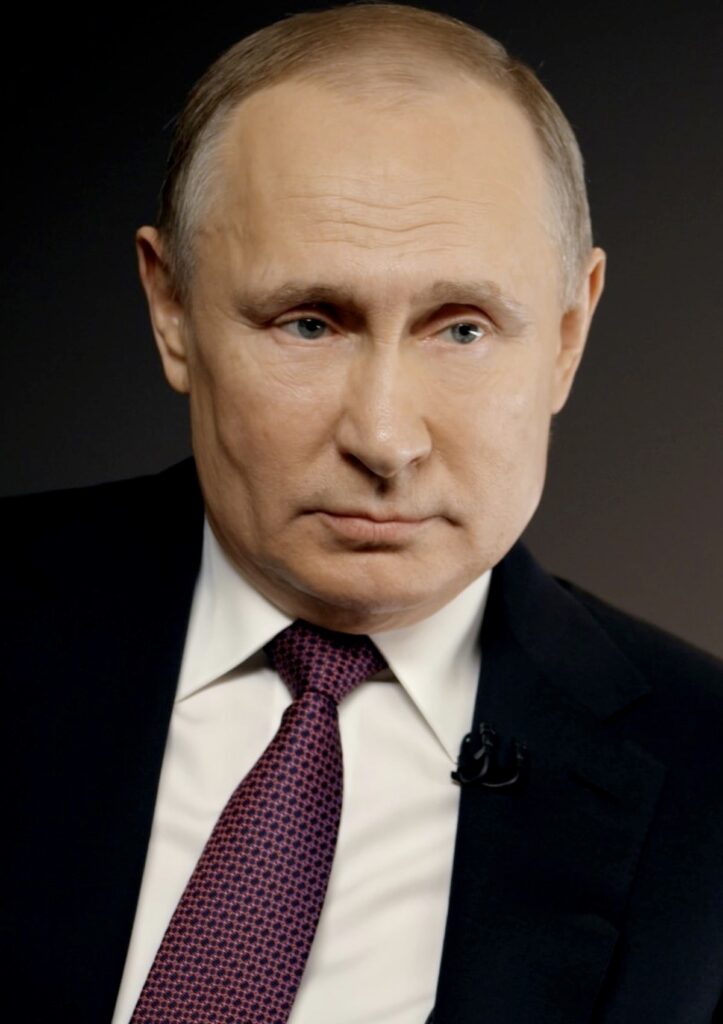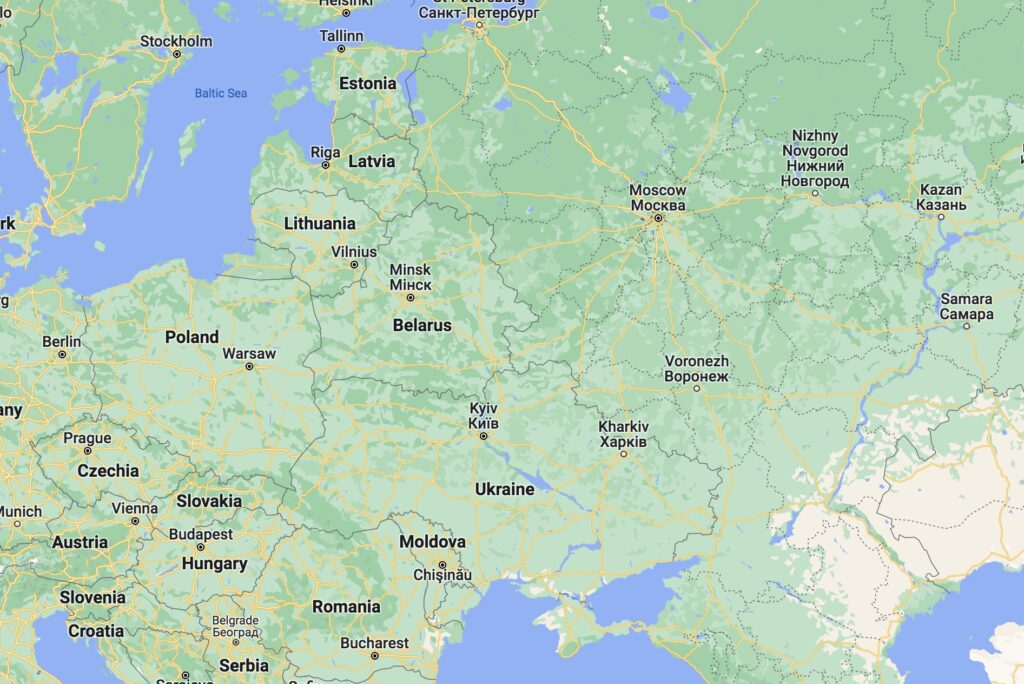Introduction
In the past I have posted several of John Ruane’s articles on this blog, mostly those he has written in support of human rights. With the invasion of Ukraine a couple of days ago by the Russian army, John, who holds a Master’s degree in Modern European History, published his take on the situation on his Facebook page. On reading John’s article I was very impressed, as he presents a view not well represented in the American press, yet which I believe is vital to a true understanding of the scene, as well as to bringing about a solution to it and restoring a real peace. At the beginning of John’s article he refers to the heartbreaking story of Tanya Savicheva, who, as a young girl lived through the siege of Leningrad by the German army from September of 1941 to January of 1944. In 1998, after reading the book “The 900 Days: The Siege of Leningrad,” by Harrison Salisbury [1], John took a pilgrimage to Leningrad (now called St. Petersburg) in Russia to visit the site of the siege for himself and to talk with still living survivors, two of whom were the parents of a woman he met on the trip named Yulia, who would become his future wife. The insight John gained from that trip to Russia, talking with the siege survivors, combined with his obvious knowledge of European history, allow him to write on the current crisis with a unique perspective derived from first hand understanding. With that backstory understood I now present John Ruane’s “The Ukraine Crisis: Lessons from History.” I hope you enjoy it and learns from it. MA
_____________________
After a long journey, I found myself standing in front of the apartment building where little Tanya and the bodies of her family were found. Eleven-year-old Tanya Savicheva[2] wrote in her notebook the dates of the death of each of her family members due to starvation: “Zhenya died 28 Dec 12:30 in the morning, 1941; Babushka (Grandmother) died 25 Jan, 3 o’clock, 1942; Leka died 17 March, 5 o’clock in the morning, 1942; Dedya (grandfather) Vasya died 13 April, 2 o’clock at night, 1942; Dedya Lesha, 10 May, 4 o’clock in the afternoon, 1942; Mama, 13 May, 7:30 am, 1942; Savichevs died. All died. Only Tanya remains.” (Though Tanya survived the siege, she would die a few months later in July, 1944 from intestinal tuberculosis. She was 14 years old) As I stood before the yellow apartment building, my heart was pounding. Not from fear, or panic, or even grief. My heart was pounding, hoping I could rush into the building and rescue brave little Tanya. But it was not to be; for it was now June 1998 and there was nothing I could do. I was fifty-six years too late...
*********
To Americans, wars take place in foreign lands, but to Europeans, war takes place in their homes, against their families. The least that I will accept for myself is to try and prevent another war, possibly a world war, like the one that killed 28 million of Tanya’s fellow citizens. Tanya and her family died in the siege of Leningrad, when from 1941-1944 the German army surrounded the city for 900 days.[3] The Russians in the city would not surrender, with about two million civilians dying in and around Leningrad.
Whether Americans are aware of it or not, we are drifting into a war, possibly World War III. Putin[4]has invaded Ukraine. Americans view him as a bully dictator trying to conquer more territory. This is a mistake.
First, go back sixty years to October, 1962. The Soviet Union had placed missiles in Cuba just 90 miles from the shores of the United States. This was such a threat to American security that President John F. Kennedy was prepared to invade Cuba and fight the Russian troops there; actions that would unquestionably start an all-out nuclear war. The Soviets insisted the missiles were for defensive purposes only. The U.S. planned to bomb the missiles before they became operational, which would have started a World War. President Kennedy and his brother, Attorney General Robert Kennedy, deftly negotiated with Soviet Premier Nikita Khrushchev. Just one day before the United States military was scheduled to begin the war, Kennedy and Khrushchev reached an agreement. Khrushchev would remove the missiles from Cuba if the United States would guarantee not to invade Cuba, as well as remove U.S. missiles from Turkey. World War III was prevented.[5]
We have the same situation now, but in reverse. The United States has missiles in Poland which will become operational later this year. The missiles are just 100 miles from the Russian border. The Russians have been insisting they be removed. The United States reply is that they are for defensive purposes only. The U.S. claims that the missiles are for the defense of Europe and America in case of an attack by Iran. (I kid you not!). Also, there are eventual plans to admit Ukraine into NATO. Keep in mind the last time a foreign hostile army (Nazi Germany) was on the Russian border those forces ended up killing 28 million Russians, with millions more wounded or rendered homeless. To give some perspective, the number of Russians killed in World War II was equal to the combined total population of the following American cities in 1940: New York, Chicago, Philadelphia, Detroit, Los Angeles, Cleveland, Baltimore, St. Louis, Boston, Pittsburg, Buffalo, New Orleans, Minneapolis, Cincinnati, Newark, Kansas City, Indianapolis, Houston, Seattle, Rochester, Denver, Columbus, and Louisville/Jackson County, Kentucky. Over 18 million of those dying were civilians.
Let that sink in a moment.
And if there is World War III this level of destruction will probably be reached on the second day. Our cities and theirs.
Russians have a different concept of war than Americans. We get our concept of war from the movies; they get theirs from the graveyards in every city and every village.
When Barack Obama was president he understood the Russian concerns and scrapped the idea of placing silo-based missiles in Poland. The Russians said then, like America said in 1962, that they will bomb the missile bases before they become operational. Now there are missiles in Poland and they will become operational later this year. If Russia bombs an American missile base in Poland, then NATO will respond and there will be World War III. Do we think Putin is bluffing?
Are we willing to risk World War III on it? Are we willing to have our children, grandchildren and ourselves suffer the fate of Tanya Savicheva?
One note about the missiles: they are not silo based but are launched from what are called MK 41 launchers, and are part of what we call the Aegis Ashore missile system.[6] NATO said the sites do not have the software, hardware, and infrastructure to launch offensive missiles; but independent analysts from the Federation of American Scientists[7] told the New York Times that, “without visual inspections, there is no way to determine whether or not this Tomahawk-specific hardware and software have been installed at the Aegis Ashore Sites in Europe.” The U.S. has not responded to the New York Times request to see the missiles.
What is to be done?
First of all, if it is true that the missiles are designed to defend Europe and the U.S. from Iranian missiles, then there is no reason to not allow Russian inspection of the missile bases to see if that is true. If fact, it would be wise to permanently station a few of their experts at the sites. There is no sane reason not to do this since it may well prevent a world war.
Second, do not allow Ukraine and Georgia to become part of NATO. Major hostile forces in such close proximity to each other is inherently dangerous, and wars have begun that way. Besides, Putin has already shown the resolve to not let this happen.
Americans despise Putin. We look at him and say he is a dictator out for conquest. But any responsible leader of Russia would do the same thing to protect the security of his country.
Writing this is all I can say or do in the hopes of preventing a devastating war. What I write here will be dismissed by many as Putin’s talking points or Russian propaganda. I hope what I wrote will somehow come to the attention of those decision makers who can prevent a war.
If you share the belief that we must not let events spin out of control by hateful rhetoric and threats, please share this article with your friends and family.
Thank you!
Addendum
John Ruane posted the above article in the early morning hours of Friday, February 25th, 2022. The next day, Saturday, February 26th, right before my publication of this article, after it became apparent that Putin had more in mind re: Ukraine than just improving Russian security, I received the following update from him:
And then this happened…. on February 24, 2022, Russian forces attacked the entirety of Ukraine. As I write this, Russian forces are besieging the city of Kiev (Kyiv). Now it is Ukrainian children, mothers, brothers and sisters, living under the terror of an invading army. By invading Ukraine, instead of simply securing the areas of Donetsk and Luhansk, which was a matter of Russian security, President Putin has invalidated his argument that this is a matter of Russian security. Russia is a proud country. But in my view President Putin has become the very thing which has brought tremendous suffering, grief, and death to Russians: he has become a belligerent invader, bombing civilians, inflicting death and destruction with a mechanized army. How the world will react remains to be seen. But President Putin has lost what the Chinese call “The Mandate of Heaven.” If Putin’s goal was to restore the old Russia then, perhaps, he has succeeded. Because what Russians now have to look forward to is the old Russia; isolated from the world and backward in its thinking.
[1] “The 900 Days: The Siege of Leningrad,” by Harrison Salisbury was originally published in 1969. Salisbury (November 14, 1908 – July 5, 1993), was an American journalist and the first regular New York Times correspondent in Moscow after World War II. He spent nearly 20 years with United Press (UP), much of it overseas, and was UP’s foreign editor during the last two years of World War II. Additionally, he was The New York Times’ Moscow bureau chief from 1949–1954. Salisbury constantly battled Soviet censorship and won the Pulitzer Prize for International Reporting in 1955.
[2] Tatyana Nikolayevna Savicheva commonly referred to as Tanya Savicheva (23 January 1930 – 1 July 1944), was a Russian child diarist who endured the siege of Leningrad during World War II. During the siege, Savicheva recorded the successive deaths of each member of her family in her diary, with her final entry indicating her belief she was the sole living family member. Although Tanya was rescued and transferred to a hospital, she succumbed to intestinal tuberculosis in July 1944 at age 14. What people were given to eat during the siege was a daily wafer (about the size of an Oreo cookie) made up of engine oil, plaster, and a few other things which the scientists could find that had some value, although ultimately harmful. Images and the pages from her diary became symbolic of the human cost of the siege of Leningrad, and she is remembered in St. Petersburg with a memorial complex on the Green Belt of Glory along the Road of Life. Her diary was used during the Nuremberg Trials as evidence of the Nazis’ crimes.
[3] The siege of Leningrad was a prolonged military blockade undertaken from the south by the Army Group North of Nazi Germany against the Soviet city of Leningrad (now St. Petersburg) on the Eastern Front in World War II. The Finnish army invaded from the north, co-operating with the Germans, and completed the ring around the city. The siege began on 8 September 1941, when the Wehrmacht (German army) severed the last road to the city. Although Soviet forces managed to open a narrow land corridor to the city on 18 January 1943, the Red Army did not lift the siege until 27 January 1944, 872 days after it began. The blockade became one of the longest and most destructive sieges in history, and it was possibly the costliest siege in history due to the number of casualties which were suffered throughout its duration. In the 21st century, some historians have classified it as a genocide due to the systematic starvation and intentional destruction of the city’s civilian population
[4] Vladimir Vladimirovich Putin (born 7 October 1952) is a Russian politician and former intelligence officer who is the president of Russia, a position he has filled since 2012, and previously from 1999 until 2008.He was also the prime minister from 1999 to 2000, and again from 2008 to 2012. Putin is the second-longest current serving European president after Alexander Lukashenko. Putin was born in Leningrad (now Saint Petersburg) and studied law at Leningrad State University, graduating in 1975. He worked as a KGB foreign intelligence officer for 16 years, rising to the rank of lieutenant colonel, before resigning in 1991 to begin a political career in Saint Petersburg. He later moved to Moscow in 1996 to join the administration of president Boris Yeltsin. He briefly served as director of the Federal Security Service (FSB) and secretary of the Security Council, before being appointed as prime minister in August 1999. After the resignation of Yeltsin, Putin became acting president, and less than four months later was elected outright to his first term as president and was reelected in 2004. As he was then constitutionally limited to two consecutive terms as president, Putin served as prime minister again from 2008 to 2012 under Dmitry Medvedev, and returned to the presidency in 2012 in an election marred by allegations of fraud and protests; he was reelected again in 2018. In April 2021, following a referendum, he signed into law constitutional amendments including one that would allow him to run for reelection twice more, potentially extending his presidency to 2036
[5] For a complete description of the Cuban Missile Crisis please see the 5-part series, “JFK and the Road to Dallas: The Cuban Missile Crisis,” published on this website, fromanativeson.com, a few years ago. The link to Part I is included here: http://fromanativeson.com/2013/04/20/jfk-and-the-road-to-dallas-the-cuban-missile-crisispart-i-by-mark-arnold/
[6] Aegis Ashore is the land-based variant of the Navy’s Aegis Weapons System. The system incorporates land-based versions of the various components used on Aegis ships (destroyers and cruisers in the US Navy equipped with the Aegis Weapons System). It is intended to serve as a midcourse defense against medium and intermediate-range missiles. The first two planned Aegis Ashore sites are at Deveselu, Romania and Redigo, Poland.
[7] The Federation of American Scientists (FAS) is an American nonprofit global policy think tank with the stated intent of using science and scientific analysis to attempt to make the world more secure. FAS was founded in 1945 by scientists who worked on the Manhattan Project to develop the first atomic bombs.







